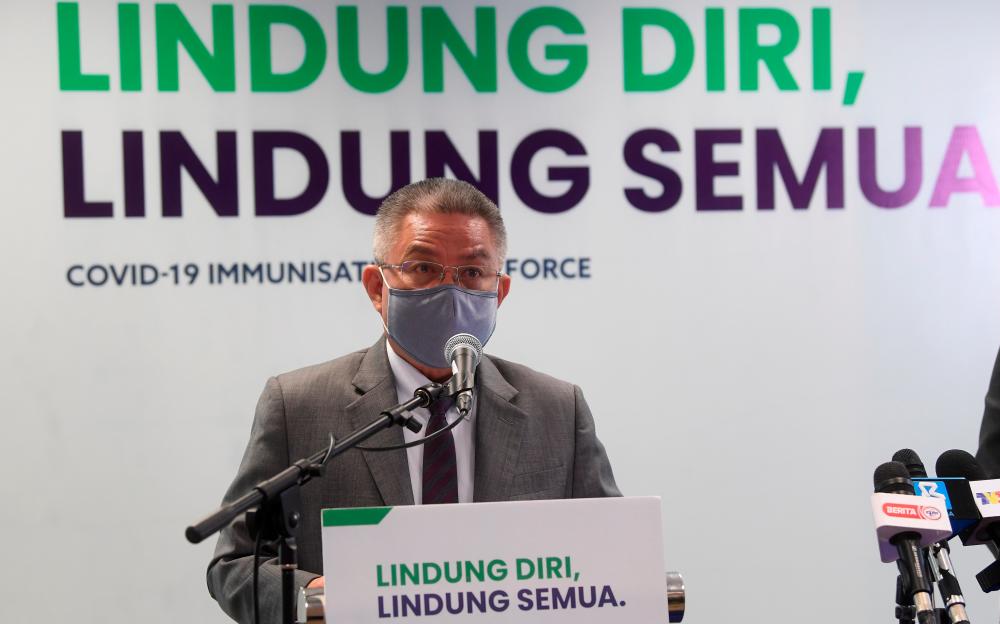This is a round-up of Covid-19 related matters in Malaysia and globally from May 1 up to noon today. In Malaysia, case numbers have exceeded 420,000 and globally, the virus has infected more than 156 million people and caused over 3.2 million deaths. More than 216 countries and territories are affected by the pandemic.
KUALA LUMPUR: The sharp rise in daily new cases over the past few weeks has once again placed Malaysia in a critical situation in its fight to contain the transmission of Covid-19.
As of yesterday, active cases had shot up to 33,762 while the nation’s cumulative caseload stood at 427,927.
Over the 24-hour period up to noon yesterday, 3,551 new infections were reported nationwide with the biggest “contributors” being Selangor (1,137 cases), Kuala Lumpur (477 cases) and Sarawak (391 cases).
Daily new cases registered in the country exceeded 3,000 on May 5 (3,744), May 4 (3,120) and May 2 (3,418).
Health director-general Tan Sri Dr Noor Hisham Abdullah has also indicated in his daily reports on Malaysia’s Covid-19 situation that new clusters were increasingly being detected.
On May 5 alone, 20 new clusters were reported with eight of them linked to the workplace and six to the community. Out of the remaining six, four were education clusters and two religious clusters.
As of yesterday, there were 418 active clusters nationwide with 96 of them reporting new cases.
There has also been an increase in Covid-19 patient admissions to the intensive care unit. Yesterday, 354 patients were in the ICU with 199 of them requiring respiratory assistance.
Dr Noor Hisham said last Sunday that usage of critical and intensive care unit beds has reached 90 percent in the Klang Valley.
The government, meanwhile, has enforced a Movement Control Order (MCO 3.0) in six districts in Selangor, namely Hulu Langat, Klang, Petaling, Kuala Langat, Gombak and Sepang effective from May 6 to May 17.
MCO has also been declared from May 7 to May 20 in Kuala Lumpur; districts of Johor Bahru, Kulai and Kota Tinggi in Johor; mukim of Taiping and districts of Larut Matang and Selama in Perak; and 14 mukim in the district of Besut (except mukim of Hulu Besut) in Terengganu.
Malaysia has also imposed a ban on travellers from Nepal, Bangladesh, Sri Lanka and Pakistan, following an earlier ban on flights from and to India to stop a new COVID-19 variant from entering Malaysia.
According to Health Minister Datuk Seri Dr Adham Baba, Malaysia has already recorded its first case of the highly transmissible Indian variant identified as B.1.617.1. He said Malaysia has also recorded 48 cases of the South African B.1.351 strain, eight cases of the UK B.1.1.7 strain and two cases of the Nigerian B. 1.525 strain.
Positive cases highest among citizens
Out of the 3,551 new Covid-19 cases recorded nationwide yesterday, 3,535 involved local transmissions while the remaining 16 cases (comprising 10 Malaysian citizens and six non-citizens) were imported.
On average, Malaysian citizens made up about 90 percent of locally transmitted cases, according to the following statistics compiled by the Ministry of Health between May 1 and May 6.
May 1 – new cases 2,881 (411,594 cumulative cases); local transmissions 2,865 (2,609 or 91.1 percent citizens and 256 or 8.9 percent non-citizens); imported cases 16 (five citizens and 11 non-citizens).
May 2 – new cases 3,418 (415,012 cumulative cases); local transmissions 3,408 (3,134 or 92.0 percent citizens and 274 or 8.0 percent non-citizens); imported cases 10 (one citizen and nine non-citizens).
May 3 – new cases 2,500 (417,512 cumulative cases); local transmissions 2,496 (2,301 or 92.2 percent citizens and 195 or 7.8 percent non-citizens); imported cases four (two citizens and two non-citizens).
May 4 – new cases 3,120 (420,632 cumulative cases); local transmissions 3,114 (2,918 or 93.7 percent citizens and 196 or 6.3 percent non-citizens); imported cases six (one citizen and five non-citizens).
May 5 – new cases 3,744 (424,376 cumulative cases); local transmissions 3,737 (3,514 or 94.0 citizens and 223 or 6.0 non-citizens); imported cases seven (one citizen and six non-citizens).
May 6 – new cases 3,551 (427,927 cumulative cases); local transmissions 3,535 (3,242 or 91.7 citizens and 293 or 8.3 percent non-citizens); imported cases 16(10 citizens and six non-citizens).
With its current cumulative total of 427,927 cases,Malaysia is at the 42nd spot (last week 43) in the list of 216 countries affected by the Covid-19 pandemic. Malaysia has now overtaken Saudi Arabia (422,316 cases) and just ahead of Malaysia is Morocco (512,656 cases).
Yesterday, 2,709 patients were discharged from hospital, bringing Malaysia’s total number of recoveries to 392,555 (91.7 percent of total Covid-19 cases).
New clusters
As of yesterday, Malaysia has recorded a total of 1,740 clusters, out of which 1,322 have ended. A total of 418 clusters are still active with 96 of them reporting new cases.
The three clusters that recorded the highest number of new cases yesterday were the Jalan Besar Sungai Jawi cluster (94), Jalan Padang Tembak cluster (75) and Industri Lengkuk Teknologi cluster (59).
The number of new clusters reported this week is as follows:
May 1: 14 comprising four community clusters, four workplace clusters, four education clusters and two religious clusters.
May 2: 11 comprising five community clusters, four education clusters and two workplace clusters.
May 3: nine comprising three community clusters, three workplace clusters, two education clusters and one detention centre cluster.
May 4: 17 comprising seven community clusters, five workplace clusters, four education clusters and one religious cluster.
May 5: 20 comprising eight workplace clusters, six community clusters, four education clusters and two religious clusters.
May 6: 14 comprising eight workplace clusters, two community clusters, two education clusters, one high-risk group cluster and one religious cluster.
Meanwhile, Dr Noor Hisham wrote on his personal Facebook account yesterday that the COVID-19 infectivity rate or R0/Rt value stood at 1.07 nationwide as of yesterday. Terengganu registered the highest R0 value at 1.32, followed by Perak 1.21 and Kedah 1.19.
The R0 value between April 24 and April 30 had been consistently above 1.0. An R0 value of 0.5 would be required in order to flatten the Covid-19 infection curve.
Covid-19 case details in Malaysia
Selangor accounted for the highest number of new cases reported yesterday at 1,137. A total of 738 of these cases were detected following the screening of close contacts; 104 from existing and new clusters; nine imported; and 286 from other screenings.
For the record, Selangor was the biggest contributor to the daily new cases recorded this week: May 1 (759); May 2 (1,200); May 3 (637); May 4 (675); and May 5 (1,548).
Six states recorded three-digit new cases yesterday, namely Kuala Lumpur 477; Sarawak 391; Kelantan 326; Penang 305; Johor 258; Perak 137; and Kedah 112.
Another six states recorded two-digit new cases, namelyPahang 97, Negeri Sembilan 85, Melaka 82, Sabah 69, Terengganu 58, and Putrajaya 12.
Yesterday, 19 deaths were reported, bringing Malaysia’s COVID-19 death tally to 1,610.
Global Covid-19 statistics
The total number of COVID-19 cases worldwide, according to Worldometer, at the time of writing this article stood at 156,681,524 (151,274,047 cases at the same time last Friday) and deaths 3,269,340 (3,182,3740 last Friday). The total number of recoveries stood at 134,042,630.
Some 216 countries are affected by the Covid-19 pandemic and those in the top 10 of the list are the United States, India, Brazil, Russia, the United Kingdom, France, Turkey, Italy, Spain and Germany. The breakdown is as follows: United States 33,369,192 cases (594,006 deaths), India 21,485,285 (234,071), Brazil 15,009,023 (417,176), France 5,728,090 (105,850), Turkey 4,977,982 (42,187), Russia 4,855,128 (112,246), United Kingdom 4,428,553 (127,583), Italy 4,082,198 (122,263), Spain 3,559,222 (78,726) and Germany 3,486,462(84,811).
China, where the outbreak was first reported at end-December 2019, is now on the 96th spot in the list of countries affected by COVID-19 with 90,739 cases while its death toll remained at 4,636.
Besides Malaysia, the three other Southeast Asian nations that have joined the list of countries with more than 100,000 cases are Indonesia with 1,697,305 cases and 46,496 deaths, the Philippines with 1,080,172 cases and 17,991 deaths, and Myanmar with 142,874 cases and 3,210 deaths.
Thailand has reported 76,811 cases and 336 deaths; Singapore 61,286 cases and 31 deaths; Cambodia 17,621 cases and 114 deaths; Vietnam 3,090 cases and 35 deaths; Laos 1,177 cases and zero fatality; Brunei 228 cases and three deaths.
Covid-19 background
According to the World Health Organisation’s website, its China country office was informed of cases of pneumonia that were detected in Wuhan on Dec 31, 2019. On Jan 7, the Chinese authorities confirmed that the novel coronavirus can be transmitted from human to human.
Coronaviruses are a large family of viruses that cause illnesses ranging from the common cold to more severe diseases such as Severe Acute Respiratory Syndrome (SARS) and Middle East Respiratory Syndrome (MERS-COV).
A study of the virus’ genetic sequence suggested similarities to that seen in snakes and bats. China health officials identified the Huanan Seafood Market in Wuhan as the source of the transmission of the coronavirus.
On Feb 11, 2020, WHO announced the official name of the virus, Covid-19, which is an acronym for coronavirus 2019 – CO stands for corona, VI for virus and D for disease.
On Jan 30, 2020, WHO declared the coronavirus outbreak as a global emergency. By then, it had spread to 18 countries and caused 170 deaths. On March 11, Covid-19 was declared a pandemic by WHO.
WHO has described the Covid-19 outbreak as much more dangerous than the A H1N1 Influenza, also known as Swine Flu.
Swine Flu, which occurred between January 2009 and August 2010, infected more than 1.6 million people and caused 18,449 fatalities.
The International Monetary Fund has warned that the global economic recession caused by the Covid-19 pandemic will be worse than the Great Depression of the 1930s. - Bernama















